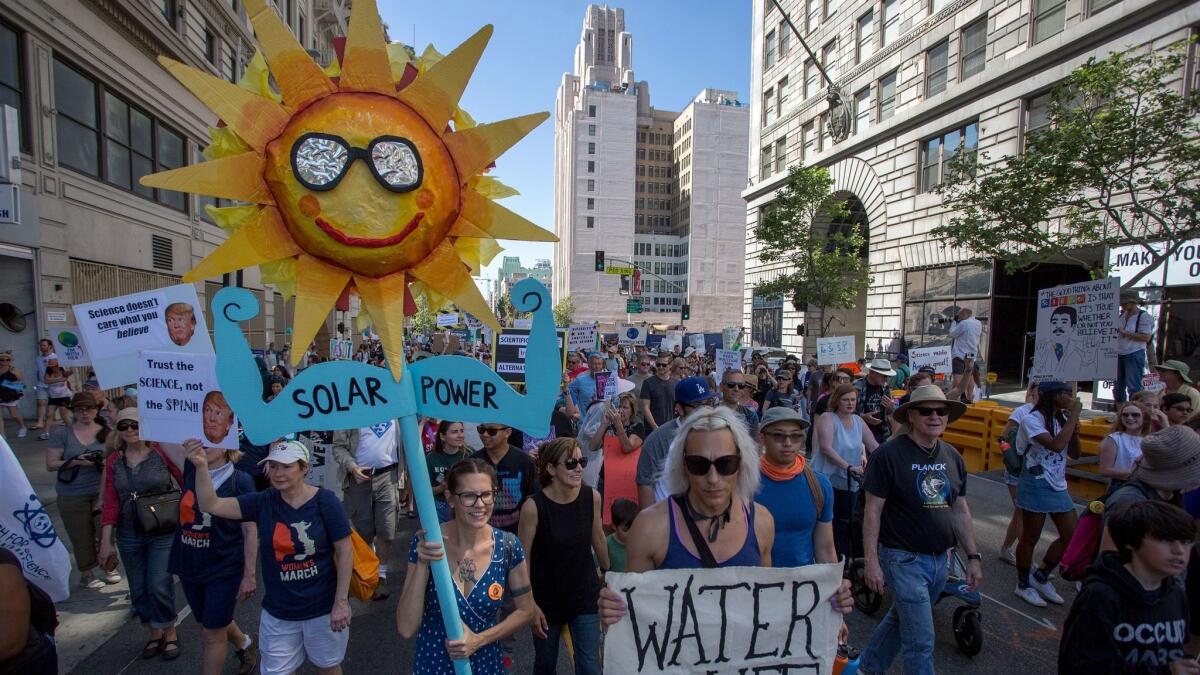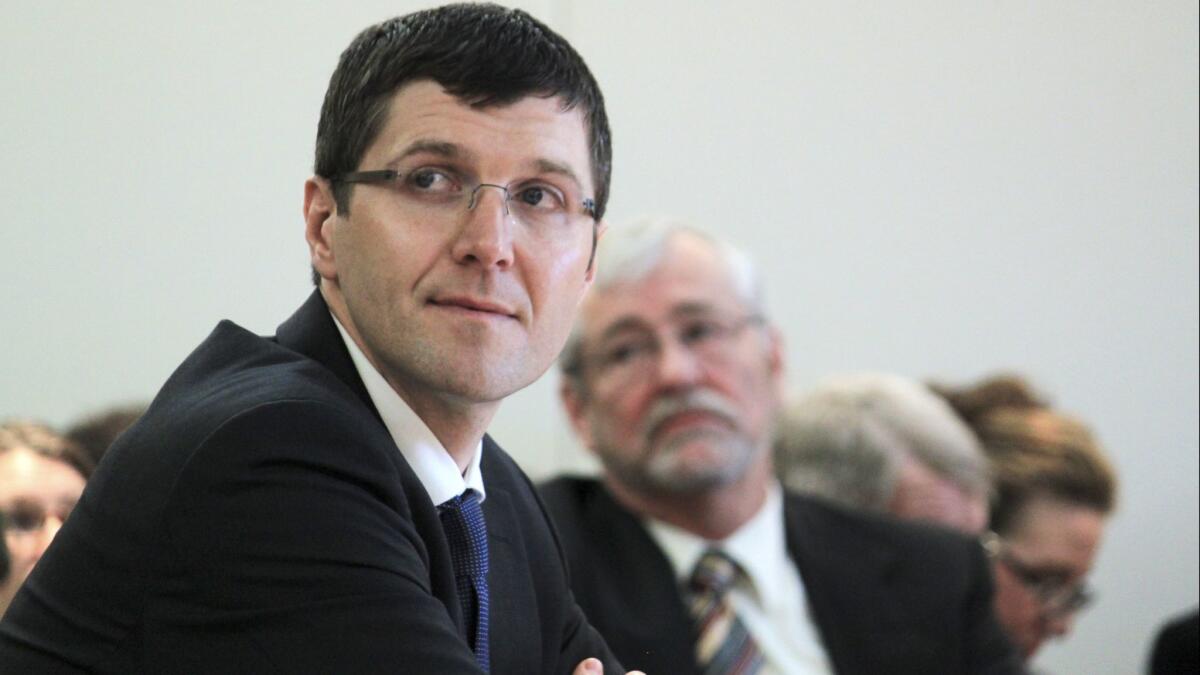No one seems to want to run Trump’s EPA in California

- Share via
Reporting from Washington — Perhaps it is unsurprising that the White House still hasn’t filled this job: San Francisco is not an inviting place for the Make America Great Again administration.
But the administration’s effort to fill one of its most important environmental jobs — chief of the Environmental Protection Agency’s headquarters for California and the rest of the Pacific Southwest — keeps going sideways.
On Tuesday, an oil and gas lobbyist from New Mexico who, according to several people inside the Trump administration, was poised to fill the post told The Times it was all a big mistake. He’d be staying put in New Mexico.
“I am not leaving my current role as Executive Director of the New Mexico Oil and Gas Association for any position at EPA or elsewhere within the federal government,” said an email from Ryan Flynn.

That unwavering declaration caught some in the administration off guard. Flynn had already been spotted at EPA offices this week, where staff in the building reported he was fingerprinted, a final step before assuming the role as head of EPA Region 9.
A New Mexico Oil and Gas Assn. spokesman said in an email late Wednesday that Flynn had not been fingerprinted. The spokesman, Robert McEntyre, also said that although Flynn heads the oil and gas industry’s lobbying organization in New Mexico, he doesn’t personally conduct lobbying.
This was at least the second time the Trump administration had an oil industry executive bow out of the running for the Region 9 job in a late stage of vetting. In other cases, candidates had been approached, but took a pass before talks got that far.
The job is proving to be one of the least sought-after leadership roles in the administration. Region 9 is the only one of EPA’s 10 regional headquarters that still lacks a chief.
The assignment is to carry out the Trump agenda — industry-friendly and averse to action to combat climate change — in one of the the nation’s most environmentally active states. The post is guaranteed to come with daily confrontation with the state’s battle-ready leaders, not to mention the hordes of protesters who can make just getting to and from work in San Francisco a professional hazard.
“The saying goes that there are nine EPA regions and then there is Region 9,” said Jared Blumenfeld, who ran that office during the Obama administration.
The passion of the scientists, enforcement officers and others who work in California, he said, has made it “nearly impossible for Trump to recruit” someone “to stand in front of the 900 EPA professionals in Region 9 and lead them and the agency over the precipice. It would be a fool’s errand,” he said.
Yet the Trump administration continues to hunt aggressively for a candidate. Flynn was cut from cloth similar to that of EPA Administrator Scott Pruitt, whose crusade to unravel scores of federal environmental rules and undermine mainstream climate science is fiercely resisted in California.
Flynn is an oil and gas enthusiast who, during his tenure running New Mexico’s state environmental agency, cut deals with industry that enraged local environmentalists. The New Mexico Environmental Law Center twice awarded him its “Toxic Turkey” prize.
The Environmental Protection Agency declined to comment on why its pursuit of Flynn went off track. But officials there said that EPA Region 9 will have its leader soon enough.
“EPA is in the process of filling numerous positions,” said an email from agency spokesman Jahan Wilcox. “We look forward to announcing a Regional Administrator for Region 9, who will be dedicated to Administrator Pruitt’s agenda of protecting the environment and human health.”
Before Flynn was in the mix, the administration had been courting Chris Paul, an executive with Gulf Oil. He, too, was well into the appointment process when things fizzled.
The stress the job would bring is not the only reason it has proved a tough sell, in particular to the oil industry officials Pruitt and President Trump seem to favor. There is also the salary cap. The pay maxes out in the range of $180,000 — probably not enough to support an oil-executive lifestyle in the Bay Area.
Or to help fund a refuge elsewhere. The Region 9 head under the administration of George W. Bush charged the government for so many flights out of San Francisco that it caught the attention of federal investigators. They ultimately concluded he was improperly billing taxpayers to get to his house in Orange County.
But the biggest drawback of the job for a Trump appointee is that everyone considered for it probably agrees with the president that California is “out of control.”
As Flynn was emailing a reporter that he likes his job in New Mexico just fine, thank you, California’s attorney general was launching yet another attack against the administration. This time it was a lawsuit to stop the administration’s plan allowing more fracking.
State Senate President Pro Tem Kevin de León (D-Los Angeles) warned in an email that whoever ultimately takes the job “is going to be held to account” for “Trump’s hostile intrusions” on California’s natural resources and shorelines.
It’s a standard battle cry these days, but it gives pause to any operative who anticipates staying in the state after Trump is gone. The administration is so toxic in California that affiliating with it can seriously damage one’s career there.
“The state has made it quite clear they oppose anything having to do with Trump,” said Jeffrey Holmstead, who was an EPA deputy administrator under President George W. Bush. “It makes it more difficult to find people who afterwards still have to make a living working with companies and agencies in California.”
For now, activists like Sierra Club legislative director Melinda Pierce are pleased to see Trump having so much difficulty with the appointment.
Out west, she said, “not even fossil-fuel lobbyists want to help Scott Pruitt.”
Follow me: @evanhalper
UPDATES:
5:45 a.m. Jan. 25: This article was updated with a statement from Ryan Flynn’s spokesman.
This article was originally published at 3:50 p.m. Jan. 24.
More to Read
Get the L.A. Times Politics newsletter
Deeply reported insights into legislation, politics and policy from Sacramento, Washington and beyond. In your inbox twice per week.
You may occasionally receive promotional content from the Los Angeles Times.











